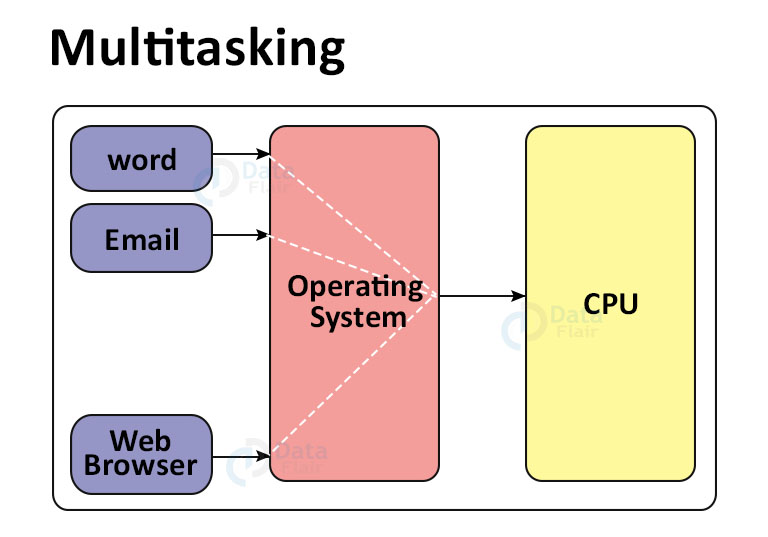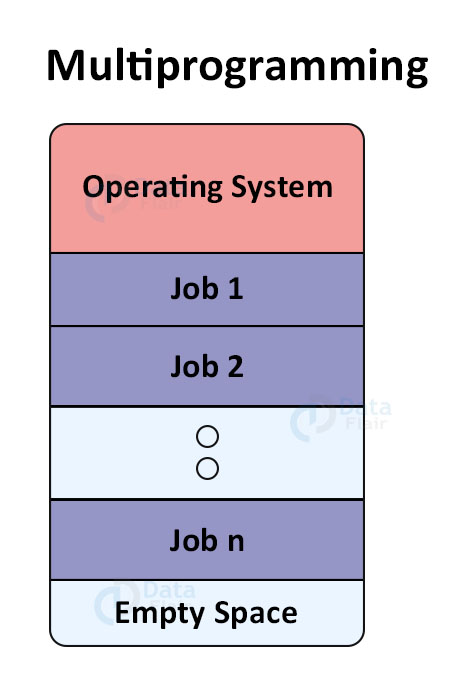Operating System Properties
FREE Online Courses: Elevate Skills, Zero Cost. Enroll Now!
In this segment, we’re going to study different properties of the Operating System because of which the system is able to perform all the functionalities that it does.
Let’s study each of them in detail.
1. Batch Processing
In this technique, the operating system groups the programs and data together in a batch before it starts processing it.
Some activities that the operating system performs for batch processing are:
- It identifies the set of jobs that are further assigned to a sequence of commands.
- The operating system executes list of number jobs that it maintains in the memory one by one which is based on some scheduling algorithm.
- It follows a first come first serve manner which means the job in the operating system that have been submitted first are processed first.
Advantages of Batch Processing
- Repeated jobs are done fast
- No user intervention needed
- No special hardware required
- Supports large organizations
Disadvantages of Batch Processing
- Lack of interaction between a user and job
- For results user must wait until batch is done
- Difficult to perform debugging
2. Multitasking
CPU performs multitasking by switching multiple jobs and executing them simultaneously. The process of switching between the jobs is performed in a very frequent and quick manner.
Some activities that the operating system performs related to multitasking are:
- When the user gives any instruction to the operating system, directly it receives a very quick and immediate response.
- Multitasking operating systems also known as time-sharing systems were initially developed at a very reasonable price to provide interactive use of the system.
Advantages of Multi-Tasking
- Saves time
- For a user, multiple files can be worked upon simultaneously at the same time.
Disadvantages of Multitasking
- For a new user, it might be a little confusing
- High chances of the computer program being affected
- Speed might be affected as well
3. Multiprogramming
When two or more than two programs are in memory at the same time, they share the processor. This technique is known as multiprogramming.
Multiprogramming depends on a single processor. As one user can’t keep the processor or the input output devices busy. So the concept of multiprogramming is introduced. It helps to increase the CPU utilisation by managing processes so that the CPU has at least one job to do always.
Some activities that the operating system does related to multiprogramming are:
- At one given time the operating system keeps many jobs in memory.
- When the operating system has to execute the job it pics and begins to execute it from the memory.
Advantages of Multiprogramming
- Throughput is increased
- Ability to prioritize jobs
- Less response time
Disadvantages of Multiprogramming
- Memory protection
- Proper job mix
- Large memory
4. Interactivity
The ability of a user by which it can interact with the computer system is known as interactivity.
The operating system does the following activities related to interactivity:
- It provides a user interface that makes it easier to interact with the system.
- In order to take input from the user, the operating system manages all the input devices.
- In order to give output to the user, the operating system manages all the output device.
5. Real-Time Systems
Real-time systems are embedded systems that are very dedicated.
- An operating system usually reads from and reacts to the sensor data in real time systems.
- The operating system has to guarantee response within fixed periods of time to make sure that the performance is correct for a certain event.
6. Distributed Environment
A distributed environment refers to multiple independent processes in a computer system.
- The operating system allocates computation logic among various physical processors.
- Each processor has its own local memory they do not share a memory or a clock
7. Spooling
It stands for Simultaneous Peripheral Operations On Line.
When the data of different input and output jobs is inside a buffer then this process is known as spooling.
- A buffer is an area in memory that is accessible to input and output devices.
- As different devices have different data access rates the operating system handles input and output devices.
- The operating system maintains the spooling buffer which is used to provide a waiting station so that the data can rest there whilst the slower devices catch up.
- As a computer can perform input and output in parallel fashion it also maintains parallel computation
Advantages of Spooling
- I/O operation of one job overlaps with the execution of the other job
- Helps exchange data between different devices having various data accessing rates
Disadvantages of Spooling
- The machine is idle when the job is waiting for I/O from disk
Summary
In this segment, we discussed the functionalities and properties of the Operating System with their diagrams.
The properties of an Operating System that we discussed are-
- Batch Processing
- Multi-tasking
- Multiprogramming
- Interactivity
- Real-Time System
- Distributed Environment
- Spooling
We also studied some basic advantages and disadvantages of some of these properties.
Did you know we work 24x7 to provide you best tutorials
Please encourage us - write a review on Google






So good for me